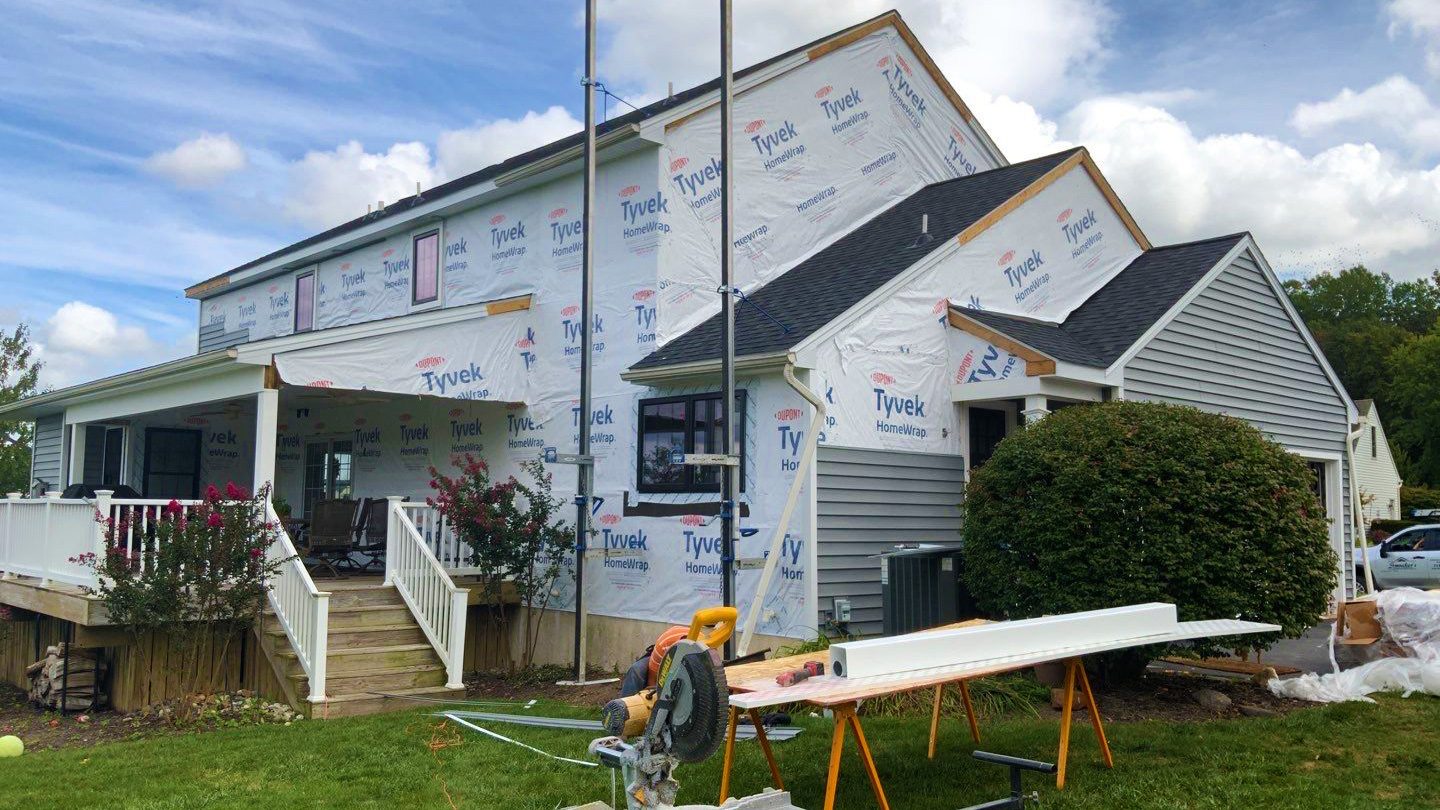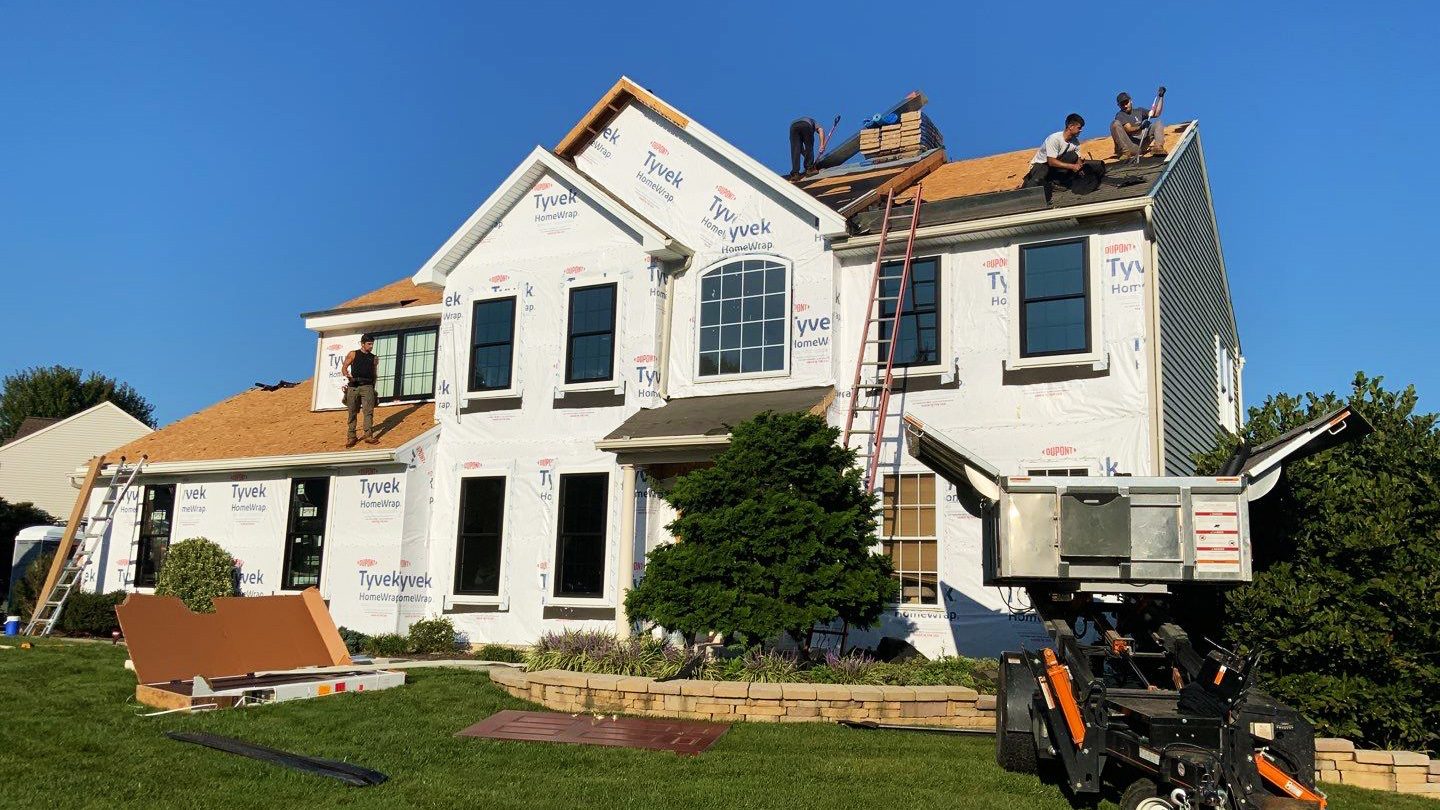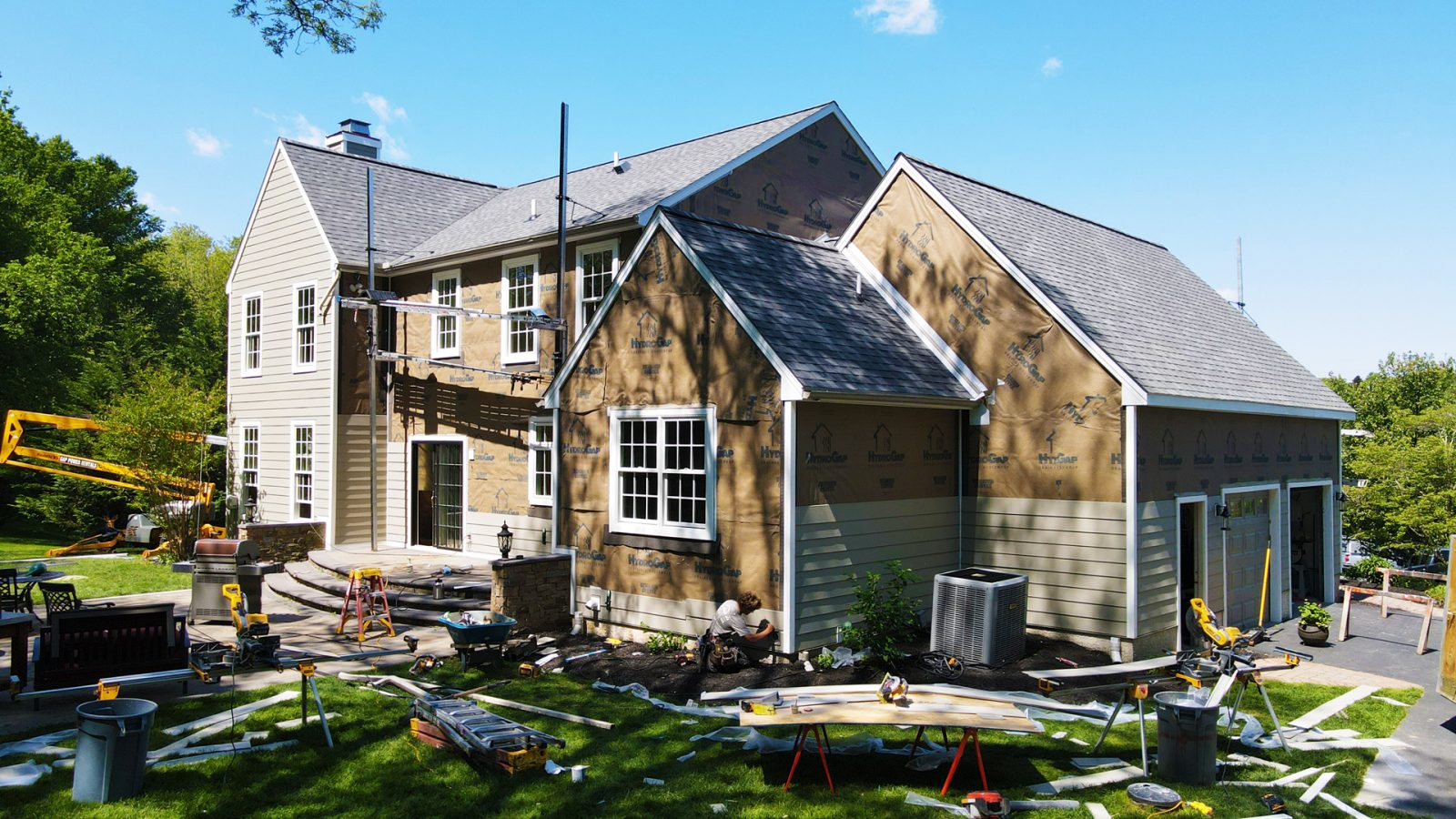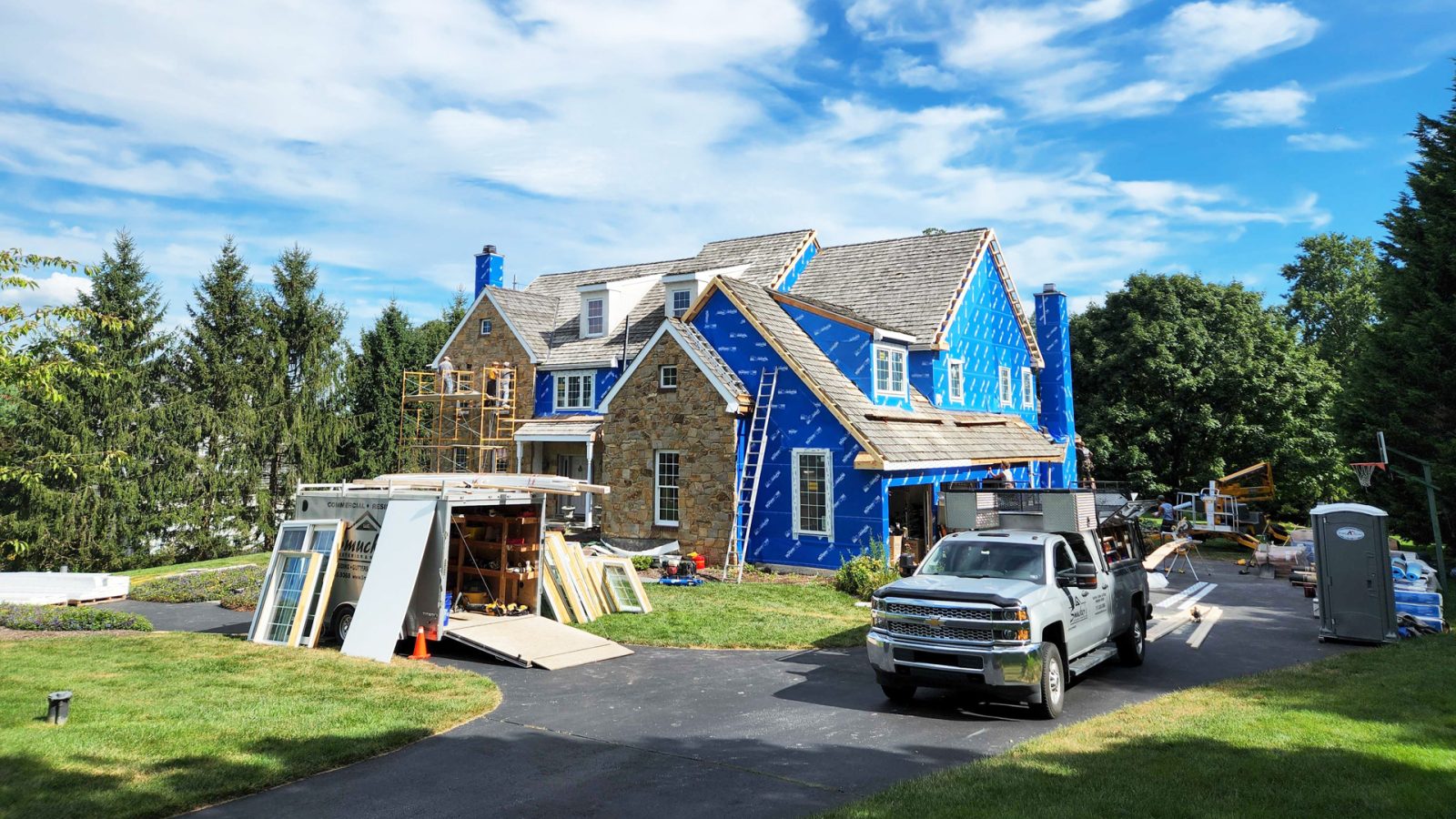EVERYTHING YOU NEED TO KNOW ABOUT HOUSEWRAPS
There are many brands and types of housewraps that you can use that add an essential layer of protection for your home. Housewraps are special protective barriers that get installed over top of the wooden exterior of your home’s walls and beneath the exterior siding or cladding. Without a protective housewrap barrier on your home, rain driven by the wind, snow melt, and condensation from the air inside your home moving out through the walls can all begin to damage the actual walls of your home.
Housewraps are also called “water resistive barriers” or WRBs for short. We may use these different terms interchangeably but know that we are referring to the same type of product unless otherwise specified.

HOW DOES HOUSEWRAP WORK?
Housewrap is a protective barrier that exists to serve 2 basic functions for your home or commercial building. It repels water and moisture protecting your structure from water and moisture damage and it allows for vapor and moisture to escape from inside your home, preventing mold and rot from the inside out.
There are many types or brands of housewraps at this point since the technology has continued to develop and advance over the years. Each product is unique and has different ratings of water resistance, permeability, tear resistance, and UV durability. Some products need to be installed using a roll-on adhesive, some simply need to be attached with staples, screws, or nails, and some products are self-adhering and simply need to be applied and then smoothed out.
There are a lot of variables to consider when choosing a housewrap product.

DO YOU NEED HOUSEWRAP FOR YOUR HOME?
Yes, aside from it now being a construction requirement, you do need a housewrap on your home. Exterior cladding like siding or stucco is designed to prevent water from reaching the walls of your home but we know that those exterior materials are not completely effective in protecting your home from water damage. No matter what material you choose, inevitably, some water and moisture will accumulate behind the cladding. Housewrap is what prevents that water or moisture from penetrating your wall cavity and causing mold and damage.
If your home is old enough that it does not have a housewrap on it it is probably not cost-effective to remove all your exterior siding just to install a housewrap. But if you end up needing to replace your exterior cladding then it is imperative that your contractor installs a housewrap and mediates any existing water or moisture damage before installing your new siding.
WHAT IS HOUSEWRAP PERMEABILITY?
The permeability of a housewrap product or the vapor permeability (same thing, different terminology) is very important to the function of the product and the safety of your home or building. It indicates how easy or difficult it is for moisture from inside your home to make its way out through the walls of your home. This is often referred to as your home’s ability to “breathe”.
Without a permeable housewrap, any water vapor or moisture coming from inside your home will get trapped in the insulation and walls of your home creating mold and rot over time. Because of this, housewrap permeability ratings are very important.
Any housewrap with a perm rating of 5 or higher will allow moisture from inside your home to safely make its way through the housewrap where it will condensate and be safely evaporated or drained away.
WHAT IS THE DIFFERENCE BETWEEN COMMERCIAL AND RESIDENTIAL HOUSEWRAP?
Yes, there is a difference between commercial and residential housewraps! Although they serve the same purpose commercial-grade housewraps and residential housewraps are slightly different. A number of companies offer both commercial and residential housewraps like Henry and Tyvek.
One of the most important differences between commercial and residential is UV resistance. On a residential installation, the length of time that the material will be exposed to the sun and its ultraviolet rays is probably much shorter than for a commercial project. UV rays from the sun can begin to damage the integrity of the housewrap if exposed for too many weeks or months. Because commercial construction projects can take longer to complete, commercial wraps are often rated for longer UV exposure technically making them more durable.

HOW IS HOUSEWRAP INSTALLED?
Just as there are multiple types of housewraps available for any commercial or residential construction building there are also multiple ways housewraps are installed. Depending on the type of housewrap being installed it may be more or less labor-intensive and more or less difficult to apply. Let’s take a look at some of the common ways housewraps are installed on buildings.
STAPLED AND TAPED HOUSEWRAP
Many of the conventional housewrap products are installed by using construction staples, nails, or screws. The seams are typically overlapped with 4-inch or 6-inch overlaps and then sealed with a special tape that goes along with each brand’s product. As you can imagine, this can be a tedious process and more time-consuming for installation.
One issue with this style of housewrap is that the staples or nails are creating tiny breaches in the surface of the housewrap. Now, housewraps are designed to function properly even with staples or nails penetrating but it should be an important consideration when choosing a housewrap product.
PEEL AND STICK HOUSEWRAP
Peel and stick housewraps are becoming more popular in the construction market as the technology improves. One challenging aspect of peel and stick housewraps is installation. While they offer a conceptually easier installation it does require meticulous attention when installing. Smoothing out air bubbles, ensuring the material is straight and aligned with every piece, and dealing with a sticky product while installing can create some challenges. When installed correctly with skill it is an excellent housewrap option and performs very well.
Some peel and stick housewraps are specially designed to seal around any staples, screws, or nails that penetrate the surface. Although not required for installation of a peel-and-stick product sometimes nails or screws have to be driven through for the attachment of other things. In these cases, self-sealing housewraps provide extra protection.
ARE ALL HOUSEWRAPS THE SAME?
No, all housewraps are not the same! In fact, housewrap products vary a lot from the size of the rolls you can purchase to the permeability rating of different products to the application process to the durability and longevity. That is why it is important to understand different types of housewrap and have your local contractor help you make the right decision of which housewrap to use on your home.

WHAT IS DRAINABLE HOUSEWRAP?
Drainable Housewrap refers to a housewrap product that combines an outer layer that is water resistant with a drainage gap to more effectively facilitate the drainage of “bulk water” off the walls of your home. Notable brands like Benjamin Obdyke and Tyvek both offer drainable housewrap products but they are not the only companies offering drainable housewrap products.
IS HOUSEWRAP INSULATION?
By definition, no, housewrap is not insulation. Insulation is installed on the interior side of the walls of your home to help with climate control and energy efficiency. Housewrap is an exterior water-resistive barrier that helps to prevent water from making its way into the wooden walls of your home. Now, housewrap technically is another layer between your home and the elements but it does not have insulative properties like real insulation does.
DOES HOUSEWRAP GO ON BEFORE INSULATION?
Housewrap does not get installed before insulation. It is the final barrier applied to your home before the exterior siding or cladding is installed. It functions to protect your home from exterior sources of moisture and water seeping in and causing mold and rot to the walls of your home. And while housewraps may help with energy efficiency they are not insulation materials and should not be thought of in that way. Housewraps are like a final layer of protection for your home before the siding is installed.
IS HOUSEWRAP WATERPROOF?
The answer to the question “Is housewrap waterproof?” is both yes and no. Housewrap as a product is designed to prevent water from getting into the wall cavity of your home. So, most housewrap products are designed to repel and channel any exterior sources of water and moisture away from your home.
But good housewraps also have a permeable quality to them in the sense that they do allow moisture to make its way from the inside of the home all the way through the walls to the outside of the house. Then once that moisture condensates on the exterior surface of the housewrap, airflow that naturally occurs in the gap between your siding and your housewrap will evaporate and dry away that moisture.
BEST HOUSEWRAP TYPES FOR YOUR HOME
In the realm of housewraps, there are many many reputable products. In this blog, we are addressing 3 of the major players in the housewrap game that we regularly use on our construction projects.
Tyvek housewrap from DuPont is probably the most well-known housewrap product, Blueskin VP100 is a newer player in the residential housewrap game, and HydroGap housewrap from Benjamin Obdyke is the most impressive drainable housewrap. All 3 materials offer a different configuration of pros and cons, we will explore all 3 here in some detail.
TYVEK HOUSEWRAP FROM DUPONT
When you think of “housewrap” you think of new home construction covered in that classic Tyvek housewrap paper. Tyvek is a time-tested and trusted housewrap product engineered and produced by the folks at DuPont.
Tyvek is a breathable, non-woven housewrap system designed for performance and efficiency. It is a non-stick material that needs to be installed with staples or nails. Tyvek does also require seam tape to ensure peak performance to protect your home or structure. Tyvek is not a drainable housewrap but it is a top-rated breathable housewrap. Boasting a perm rating of 54, this will allow your home to vent moisture from the interior of the home so that mold and rot do not build up from the inside.
TYVEK HOUSEWRAP BENEFITS:
- Permeability rating allows airflow and your home to “breathe”
- Cost-effective
- Simple and straightforward installation
- Improves home energy efficiency
- Water resistant to keep your home’s wall cavity dry

HYDROGAP HOUSEWRAP FROM BENJAMIN OBDYKE
HydroGap drainable housewrap by Benjamin Obdyke is a leading drainable housewrap material. This housewrap features special 1mm compression-resistant spacers that create a superior drainage gap between the housewrap and the sheathing (siding).
Benjamin Obdyke claims that their HydroGap Housewrap allows for 100X more bulk water drainage than other drainable housewrap products. Another unique feature of the HydroGap is that it is omnidirectional. This means that it can be installed in any direction so if you accidentally install a section upside down or sideways it will still function properly because of the intentional spacer layout. It is also a seam tape optional material meaning that if you adhere to their horizontal 4-inch overlaps and 6-inch vertical overlap specifications you do not need to use seam tape which saves time on installation.
HydroGap is also rated for 120 days of UV exposure, meaning that it can be exposed to the sun and elements for 120 days during installation before the integrity of the product is compromised. The permeation rating of HydroGap is 16 meaning that it allows your structure to breathe while still protecting against rain and snow melt.
HYDROGAP HOUSEWRAP BENEFITS:
- Canadian Construction Materials Centre Approval
- Omni-Directional installation design allows for easy installation in any direction
- Rated to drain 2x as fast as other drainable housewraps
- Tested to shed 100x more bulk water than standard housewraps
- HydroGap’s 1mm drainage bead spacers ensure a continuous drainage surface
- Vapor permeability allows your home to “breathe”
- No required seam tape on installation

BLUESKIN VP100 HOUSEWRAP FROM HENRY
Blueskin VP100 is a newer residential housewrap product. Originally Henry’s Blueskin housewrap product was only available for commercial projects. In recent years though Henry began offering a residential version of their self-adhering housewrap.
Blueskin VP100 is water-resistive and vapor permeable. This means it adequately allows your home to “breath” while effectively repelling rain or melting snow that finds its way behind your home’s exterior cladding. Henry’s Blueskin is a superior housewrap as it is self-adhering and self-sealing. You don’t need any staples, nails, or screws to install this product and when using the correct overlaps for vertical and horizontal seams, no seam tape is required.
When you happen to run any nails or screws into Blueskin VP100 it automatically seals around the screw or nail which means the integrity of the housewrap is not in danger. This is a really notable and beneficial feature of this product and is a selling point for contractors and homeowners.
Product testing of Blueskin VP100 proved that it offers more than 95% drainage efficiency which is an impressive specification. It is quickly becoming a popular housewrap option for residential installations thanks to its easy peel-and-stick installation and its self-sealing nature. Contractors need only to smooth pieces of Blueskin out with the included application tool as they install over a structure.
BLUESKIN VP100 HOUSEWRAP BENEFITS:
- Reduces mold growth and thereby improves air quality in the home
- The peel-and-stick installation process is simple and efficient
- 95% or greater drainage rating makes it a top-quality housewrap
- Can reduce energy costs for a home due to the reduction of uncontrolled air leakage
- Self-sealing around screws, nails, or staples improves water tightness to protect the home

2 OF THE BIGGEST HOUSEWRAP BENEFITS:
Housewrap on a home offers a number of very important benefits. We will detail these important benefits here as they are worth highlighting. Not all homes have housewrap. Previous to 2018 Housewraps were not required as part of the building structure. But they have been in use for many years before that.
1. HOUSEWRAP PROTECTS AGAINST DRIVING RAIN
The exterior cladding of your home (i.e. siding or other material) is designed to protect your home from the elements. The reality is that in most cases this works well. But in the presence of driving rain, prevailing winds, and excessive snowmelt in applicable regions of the country your home’s exterior cladding is not enough. That is where a qualifying housewrap comes in. Housewraps are the second layer of defense beneath your siding or other cladding material that aids in the protection of your home. Any driving rain, prevailing wind, or excessive water runoff that may make its way behind the siding of your home is stopped by the housewrap before it would otherwise enter the wall cavity of your home causing damage.
2. HOUSEWRAP ALLOWS YOUR HOME TO BREATHE
While the most obvious function of your home’s housewrap is to keep water and air out of your home it also allows moisture from within your home to escape safely. Without a housewrap on the walls of your home, interior moisture will make its way out of your house and condensate on the wooden exterior walls of your home. This can cause rot and mold to take place. When your home is equipped with a housewrap, the moisture will condensate on the surface of the housewrap and will not be able to saturate and damage the walls of your home.
If you have a drainable housewrap then the special drainable beads on your housewrap will allow this condensation to drain off and away from your home. If your housewrap is not drainable, naturally occurring airflow convection will evaporate this resting condensation without damaging your home.

GET YOUR HOUSEWRAP QUESTIONS ANSWERED
If you have more questions about housewrap products like what housewrap would be best for your home or why Smucker’s chooses to use products like Tyvek, HydroGap, and Blueskin VP100 please reach out to us through our contact form. We would love to answer your questions and potentially help you out with your exterior home projects. If you find yourself within our actual service areas feel free to view our project gallery to see if the quality of work we do is what you are looking for!




.jpg)
